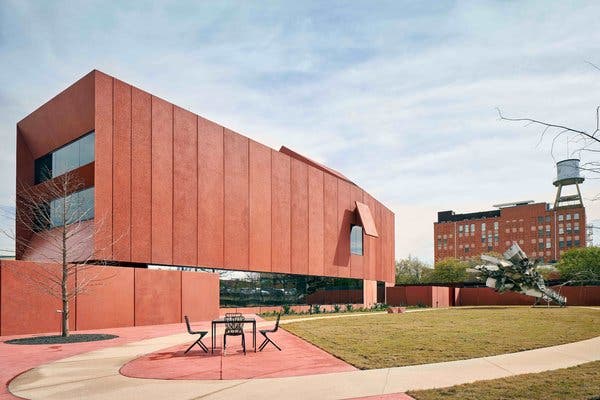
Red Jewel of Texas
Linda Pace, a philanthropist and heir to the Pace Picante salsa fortune, dreamed (literally) about a building to show selections from her 900-work collection of contemporary art. Twelve years after her death in 2007, that vision is finally being realized in San Antonio. Ruby City, a 14,000-square-foot arts center designed by the British architect David Adjaye, opens Oct. 13 with an exhibition of works by Do Ho Suh, Teresita Fernández, Isaac Julien and Cornelia Parker, among others.
As the name suggests, Ruby City’s most distinctive feature is its jewel tone; the upper part of the exterior is made of a red-colored precast concrete embedded with multihued crushed glass.
Mr. Adjaye, most famous for designing the Smithsonian Institution’s National Museum of African-American History and Culture, described Ruby City as a “monolithic treasure box.” A newcomer to working in Texas, he added that it was influenced by local architectural traditions that adapt to hot weather. “Like in an old pueblo house, you don’t have a lot of big apertures,” he said.
The architect got to know Ms. Pace and her art before she died, enabling him to customize the building for the collection, including a high-ceiling gallery for the tallest works. The crimson theme came to Ms. Pace in a dream, and Mr. Adjaye used the ensuing drawing she made as a jumping-off point.
“I wanted to acknowledge her sketch, but it wasn’t a literal instruction,” he said. “It represented hope.” Information: rubycity.org TED LOOS
Skateboarding in Style
Columbus, Ind., is known as a mecca of postwar modern architecture, with churches, libraries, and post offices designed by Eliel and Eero Saarinen, I.M. Pei, Harry Weese and a host of other big names. The city’s latest destination is somewhat smaller: a skatepark, albeit one with an international design pedigree. Jolie Crider Memorial Skatepark 2.0, designed by Janne Saario, a Finnish landscape architect and former professional skater, opened in early September. The skatepark bridges the past and future of Columbus, with Mitchell Giurgola Architects’ 1972 Columbus East High School right across the street.
The podcast “99 Percent Invisible” got Mr. Saario the job: Jonathan Nesci, a designer who lives in Columbus and is the father of a skater, cold-emailed the architect after listening to “The Pool and the Stream,” a 2017 episode about the connection between curvaceous swimming pools and skatepark design featuring Mr. Saario. Mr. Nesci eventually gave Mr. Saario one of his mirror-polished side tables in return for a conceptual design. Hunger Skateparks, in Bloomington, Ind., signed on to build the $400,000, 14,000-square-foot project, with support from the city, the county’s Heritage Fund, the Columbus Park Foundation and local donors. The new concrete skatepark is far more durable than its predecessor, as well as more seamlessly integrated into the landscape, reflecting the same investment in advanced design as those public works of the 1950s and 1960s. Information: columbusparkfoundation.org ALEXANDRA LANGE
Great on Paper
A mere 193 years after his death in 1826, the visionary French architect Jean-Jacques Lequeu is having his first solo show in the United States. An exhibition of 50 of his drawings of architectural fantasies — from funerary urns for fictitious people to finely drawn Gothic temples — opens Oct. 4 at the Menil Drawing Institute in Houston.
The work has not received its due. Less than a year before he died in poverty at the age of 68, Lequeu, who had settled into a career as a surveyor and cartographer, gave all his architectural drawings to the Bibliothèque Nationale de France, where they languished for years (including the erotic ones).
Edouard Kopp, the chief curator at the Menil Drawing Institute, described Lequeu as a “man of encyclopedic knowledge” and his visual fancies as pre-postmodern. “Imagining architecture on paper you can give your imagination free rein; there’s no worry about clients’ needs or building constraints,” he said.
“Jean-Jacques Lequeu: Visionary Architect, Drawings from the Bibliothèque Nationale de France” runs through Jan. 5, then travels to the Morgan Library & Museum in New York City, where it will be on view from Jan. 31 to May 10, 2020. Information: www.menil.org ARLENE HIRST
Flame Keeper in the Windy City
Amid this year’s centennial celebrations of the founding of the Bauhaus comes a documentary about the person who probably did the most to spread the multidisciplinary message of Germany’s radical school of modernism to America: the Hungarian-born artist Laszlo Moholy-Nagy.
An instructor at the Bauhaus who fled Europe when the Nazis came to power, Moholy-Nagy eventually settled in Chicago and in 1937 opened The New Bauhaus, which is also the name of the film. The school lasted only a year, but Moholy-Nagy resurrected it as the Chicago School of Design (now the Institute of Design, part of the Illinois Institute of Technology), emphasizing experiential learning. Students mastered the use of table saws, shaped wood into forms that felt good to the touch and went on to create such enduring designs as the curvaceous Dove soap bar and the squeezable plastic honey container in the shape of a bear.
Today, when newcomers to America are often regarded as suspect, Petter Ringbom and Marquise Stillwell of Opendox, the film’s production company, seek to highlight Moholy-Nagy‘s contributions as an immigrant. He never gained the recognition of Bauhaus leaders like Ludwig Mies van der Rohe, but Moholy-Nagy kept alive “the idea of unifying different disciplines,” said Mr. Ringbom, also the film’s cinematographer.
Directed by Alysa Nahmias and featuring archival footage and interviews with Moholy-Nagy descendants, “The New Bauhaus” premieres Oct. 16 at the Architecture & Design Film Festivaln New York. Information: adfilmfest.com JANE MARGOLIES







